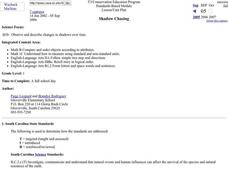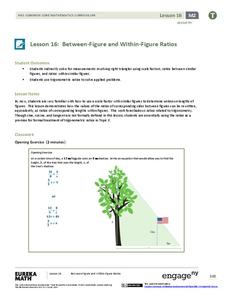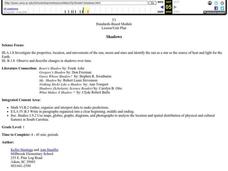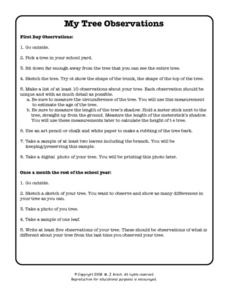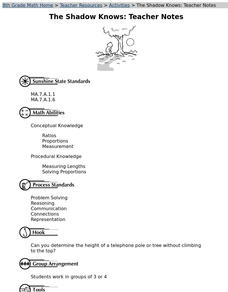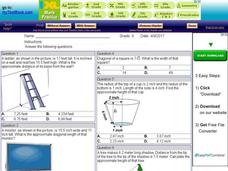Curated OER
Sunshine and Shadows
Students measure their shadows early in the morning, record direction of shadow, make marks in ground with chalk or tape, measure with ruler, and record results. Students repeat process at noon, and then later in afternoon. Students...
Curated OER
Shadow Chasing
First graders observe and measure their shadows. They go outside at three hour increments during the course of a day. Each time students measure and record the length of their shadows. Students read books about shadows and discuss why...
Curated OER
Learning Lesson: The Shadow Knows II
Students discover and practice how to calculate the circumference of the Earth. They measure the length of their shadows and use the distance they are away from the equator to complete the calculations. They discuss winter or summer...
EngageNY
Between-Figure and Within-Figure Ratios
Tie the unit together and see concepts click in your young mathematicians' minds. Scholars apply the properties of similar triangles to find heights of objects. They concentrate on the proportions built with known measures and solve to...
Curated OER
Shadows
First graders measure how a shadow changes over the course of a day. They write about what they would do if they lost their shadow, and make silhouettes of themselves. Students make up a shadow dance and read stories about shadows.
Curated OER
Seasons and Shadows: Investigate How Shadows Shift Throughout the Year
Students examine their shadows and why they are different in the summer and winter. In this seasons lesson plan students complete an activity to see how the earth's tilt on its axis changes the length of shadows.
Curated OER
Sundials: Observing and Using Shadows
Learners build sundials and observe changes in shadows over the course of one or more days. They identify patterns in the shadows and discuss how shadows may be used to tell time.
Curated OER
Ratio Word Problems
In this ratio worksheet, students solve and complete 10 different problems that include determining various ratios of events. First, they determine the height of a building given the time of day and shadow it casts. Then, students...
Curated OER
Individual Sundial (Cloud/Rain Activity)
Students make a simple sundial to examine the changes in shadows over time. In this sundial and shadow instructional activity, students make a simple sundial out of a manila folder and pencil. They observe how shadows change over time,...
Curated OER
Knowing North: Understanding the Relationship Between Time and The Sun
Students determine how to find North using a watch and their shadow. For this finding North lesson, students go outside on a sunny day and work with their shadow and a wrist watch to find out which direction that North is. They examine...
Curated OER
Sun Shadow Cycles
High schoolers use diagrams to review how the Earth rotates around the sun. In groups, they use the same diagrams to explain how the sun shadows are produced and how they differ between seasons. They describe the Earth's rotation and...
Curated OER
Plants and Shadows
In this science worksheet, students design an experiment to measure the effects of sunlight exposure upon plants while comparing the amount of shade as a correlation.
Curated OER
Studying Shadows
Young scholars measure shadows and explore the altitude of the sun. In this sun lesson students will graph the length of shadows and solar altitude against time.
Curated OER
In the Rain Shadow
Young scholars charts the rainfall averages on either side of a mountain range. In this water cycle lesson, students discover that mountain ranges affect weather patterns. Young scholars pretend they are air traffic controllers and must...
Curated OER
My Tree Observations
In this tree observation worksheet, students pick a tree that they observe over the course of a school year. They make observations, they sketch the tree, they take photographs of the tree, they get a leaf sample. They estimate the tree...
EngageNY
How Far Away Is the Moon?
Does the space shuttle have an odometer? Maybe, but all that is needed to determine the distance to the moon is a little geometry! The lesson asks scholars to sketch the relationship of the Earth and moon using shadows of an eclipse....
Curated OER
Tell Time With Your Feet
Students discover what the latitude and longitude of their location is. They start walking and measure their shadow. They fill in a chart to discover the approximate time.
Curated OER
It's Time to Make Time!
Students explore the evolution of time measurement, and explain the relationship of sunrise/sunset to length of daylight. They collect data and calculations to determine length of daylight during a given day.
Curated OER
Indirect Measurement with Similar Triangles
Students use similar triangles to find missing heights. In this using similar triangles to find missing heights lesson plan, students use proportions to find the heights of missing side lengths. Students find the height of trees and...
Curated OER
The Shadow Knows - Measuring Other Students
Eighth graders measure height and shadow length of other students on a sunny day and develop a ratio. They apply the ratio to other students and objects using shadows to determine height.
Curated OER
Measuring the Sun's Diameter
Students project and measure the suns image using a refracting telescope. In this sun's diameter lesson students calculate the magnification of the telescope and determine the diameter if the Sun.
Curated OER
Ten Multiple Choice Length Problems
In this distance activity, students calculate the lengths of sides and diagonals of figures. Students also compute lengths in shadow problems. The solutions are provided by clicking on the "show answers" tab at the bottom of the page.
GLOBE Program
Calculating Relative Air Mass
Combine math and science with fun in the sun! Scientists build a solar gnomon using reusable materials to calculate relative air mass. Mathematicians measure the pole's shadow and use the data to solve for relative air mass....
Curated OER
3-D Cubes
Students investigate cubes. For this geometric solids lesson, students review geometric concepts previously taught, then logon to a computer game in which they find cube figures and identify the shadow of hidden cubes.



